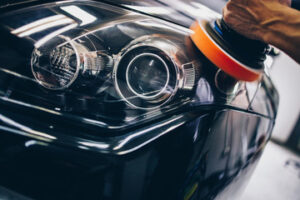Car Detailing is a precise process of cleaning and protecting cars to keep them looking like new. Detailing professionals use high-quality products and tools to clean surfaces inside and outside vehicles and apply protective coatings to prevent fading or damage.

Before you start detailing, stock up on your basic tools and supplies. You may also want to invest in a business management app that can help you set up packages, pricing, estimates, and invoices. Visit Website to learn more.
As any car owner knows, a clean exterior is essential for keeping your vehicle safe and looking great. However, it can be difficult to get a professional-like shine without the right products and know-how. That’s where professional detailing comes in. A full car detail includes not only a thorough wash of all surfaces, but also decontamination and protection to help the paint look its best. More advanced detailers or those seeking a showroom finish may also perform an additional step to correct minor swirl marks, scratches and etchings.
The first step in a full exterior detailing service is to gently wash the car using high quality products to remove contaminants, including grit and road salt. This process can be performed by hand or in a high-powered jet washing system. The next step is to hydrate the paint with clay bar treatment or an all-purpose cleaner to loosen embedded contaminants that can’t be removed by washing alone. This is done by applying the product to a damp surface and agitating it with various brushes.
After the surface is conditioned, it is rinsed and prepped for washing using the 2-bucket method. Then, the vehicle is washed with a quality auto shampoo or clay bar treatment and then rinsed. Lastly, the wheels and tires are rinsed and scrubbed with a specialty product to get rid of stuck-on contamination, and the glass and mirrors are washed.
A good quality ceramic sealant or wax protects the paint after it is cleaned, helping it retain its shine and keep contaminates from scratching it. This is a vital part of any detailing service, and it can make the difference between a car that looks like new and one that has faded or dulled over time.
Aside from this, a full detail should include services like leather conditioning and steam cleaning, road salt stain removal, deodorizing, and much more. Many detailing companies offer packages and pricing in advance, and some even use a business management app to track their customer database, price lists, branded invoices, bookkeeping (through QuickBooks), payment processing, and more.
Interior
The interior of a vehicle requires the same level of attention as the exterior. This includes a thorough cleaning to protect surfaces, prevent damage and improve the appearance. It goes far beyond a simple vacuuming job to include the removal of all dirt and debris, as well as shampooing seats, carpets and leather. It can also include deodorizing and ozone treatments.
Having your car professionally detailed can help preserve the value of your vehicle. When you show potential buyers that you take care of your car, it will help you get a better price when the time comes to sell.
Regular cleaning can also help you avoid expensive repair bills in the future. Dirt and grit can cause rust, which will eventually ruin your interior and mechanical components. It is best to detail your car at least twice a year to ensure that all surfaces are protected and looking their best.
Even brand-new cars can benefit from detailing. Many dealerships wash their vehicles without the necessary skill, which can leave clear coat scratches and swirl marks. Detailing is a process that can remove these defects to give you a much glossier finish.
When you detail your car, it can last longer and look newer. Having it done on a regular basis will keep the resale value high and prevent the need for major repairs.
While you may think of detailing as an unnecessary expense, it is a service that is well worth the investment. It can protect your car from a variety of elements, including sunlight and road salt, which can cause damage over time. Detailing can also help you save money on fuel, as a clean engine can run more efficiently. It is important to choose a professional who has years of experience and the proper equipment to complete the work. A great way to find a quality detailer is by asking friends and neighbors for recommendations. Depending on the level of detail you need, the service can take as little as one day or several days to complete. There are even mobile services that come to you, saving you the hassle of having to take your car to a shop.
Paintwork
If a car is in bad shape, detailing will make it look like new, or even better. It may also help prevent future damage from rain, road salt, and sunlight by applying protective coatings to the paint and upholstery. Typically, professional detailers use specialized cleaning products and tools to do this. Unlike running your car through a drive-thru car wash, detailing has a much more thorough clean that gets into cracks and crevices to remove dirt, leaving the paintwork smooth and shiny.
The most important part of any auto detailing service is the interior. It involves a comprehensive cleaning of the seats, mats, headliner, trunk, and all other surfaces inside the vehicle. This includes vacuuming, shampooing (or steam cleaning), leather conditioning, washing the windows, and a natural deodorizing technique that uses an ozone generator. Some details also include a headlight restoration, engine cleaning, and the application of an odor eliminator.
While the most common reason to have a car detailed is to get it as close to “new” as possible, there are many other reasons to choose this option. For example, people who have luxury cars often want to keep their vehicles looking pristine, while those who just bought a used car might want to protect it so it retains its value.
Some detailing services provide additional benefits such as fabric protection, which helps preserve the condition of the seat covers, carpets, and other fabrics in the car. These products are usually applied with a spray or brush and can help prevent dirt, dust, and other debris from sticking to the surface. Some detailing services also offer ceramic coating, which can protect the car’s paint from scratches and other damage.
It is important for those who want to start a car detailing business to understand exactly what the process encompasses. This will help them determine whether it is something they want to take on themselves or if it is a service they would rather leave to professionals. Moreover, it will also allow them to set realistic expectations for customers, which in turn will help prevent misunderstandings and cost overruns.

